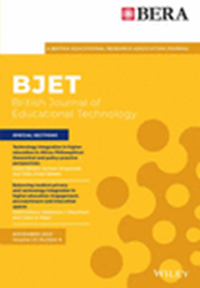Integrating a movement-based learning platform as core curriculum tool in kindergarten classrooms
Abstract
Incorporating immersive technologies in education has become increasingly popular due to their ability to facilitate active learning and engage students in the acquisition of concepts and skills. One form of immersive technology includes educational games that incorporate movement interaction, allowing children to engage with in-game elements by either immersing their own image within the game environment or by controlling an avatar using their hand and body gestures. Nonetheless, successfully incorporating these technologies into classrooms with sizable student populations presents a challenge, necessitating the implementation of a well-considered design approach. This paper introduces a systematic learning design approach facilitating the integration of a movement-based learning platform as a core curriculum tool in multimodal learning stations within authentic Kindergarten classroom settings. The design approach was evaluated in a case study involving three kindergarten teachers and 49 students conducted over a full school year. Progress data were gathered utilizing a combination of quantitative and qualitative evaluation tools. Analysis of the data suggests that integrating multimodal learning activities led to improvements in overall academic performance, particularly in critical mathematical skills compared to pre-test scores. Teachers expressed a positive attitude towards the integration of movement-based games using the learning design approach, finding it to be beneficial and effective for student learning. The study emphasizes the importance of purposeful design in creating immersive learning experiences and underscores the significance of utilizing multiple representations to enhance student motivation and engagement. The proposed systematic learning design approach has the potential to be applied to a broad range of grade levels, academic subjects and educational contexts to facilitate the integration of immersive technologies.
Practitioner notes
What is already known about this topic?
- Immersive technologies are becoming popular in education.
- Immersive technologies have been shown to enhance skills and enable the collection of multimodal data to better understand learning processes.
- The movement-based learning games fall under the category of immersive technologies that merge real and virtual worlds.
- Designing effective immersive learning experiences for these new technology-enhanced learning environments remains a question.
What this paper adds
- A proposed systematic learning design approach that demonstrates the way that movement-based learning games can be used seamlessly as core curriculum tool in authentic kindergarten settings for an entire school year.
- Ways to engage effectively a large classroom of 20 or more students with movement-based learning games.
- Findings regarding the impact of the movement-based games on student engagement, academic achievement, cognitive development and social–emotional growth.
- Teachers' perceptions and attitudes towards executing movement-based learning experiences in their classrooms using the proposed systematic learning design approach.
Implications for practice and/or policy
- In-service kindergarten and primary school teachers can adopt the proposed systematic learning design approach to integrate immersive technologies into the curriculum. This ensures that these technologies are used consistently throughout the school year, providing continuous and engaging learning experiences.
- School district administrators can use the proposed approach to develop training programs for pre-service and in-service kindergarten and primary school teachers, focusing on understanding the immersive technology, managing large classrooms and integrating the games into daily lesson plans.
- School administrators can implement the proposed systematic learning design approach to establish robust systems for monitoring and assessing the impact of immersive technologies on student engagement, academic achievement, cognitive development and social–emotional growth.
- Special education in-service teachers can leverage the flexibility of the movement-based learning games to design personalized learning experiences for their students with special needs. This involves adjusting the difficulty level, pace and type of interaction to meet individual requirements.
- Special education administrators can promote the use of the proposed approach to foster an inclusive learning environment where all students, regardless of their abilities, can participate and benefit from the immersive technologies.





 求助内容:
求助内容: 应助结果提醒方式:
应助结果提醒方式:


